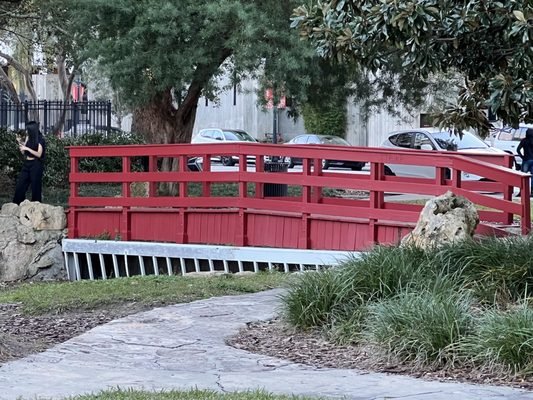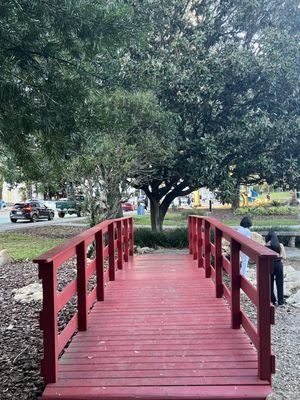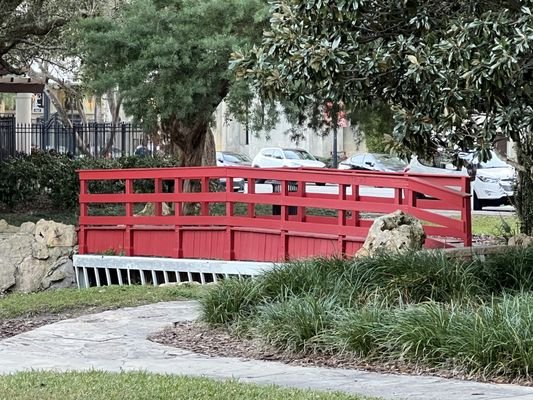Immerse yourself in the tranquility of the Japanese Rock Garden, nestled in the heart of Orlando, FL. This hidden gem offers a serene oasis for locals and tourists alike, providing a peaceful escape from the bustling city. With its meticulously designed rock formations, lush greenery, and tranquil ponds, the Japanese Rock Garden exudes a sense of serenity and harmony. Whether you’re seeking a moment of solitude, a peaceful walk, or a place for quiet contemplation, this enchanting garden is the perfect destination to unwind and reconnect with nature. Discover the beauty and serenity of the Japanese Rock Garden today.
Overview of Japanese Rock Garden
1.1 Introduction to Japanese Rock Gardens
Japanese rock gardens, also known as Zen gardens or dry landscapes, are a unique and beautiful form of art and design. They originated in Japan and have become popular attractions around the world. These gardens are meticulously crafted to create a peaceful and calming atmosphere, allowing visitors to experience serenity and tranquility.
1.2 History and Origin
Japanese rock gardens have a long history dating back to the 14th century. They were influenced by the principles of Zen Buddhism and were originally created as meditation spaces for monks. Over time, Japanese rock gardens evolved into a form of art, combining elements of nature, architecture, and spirituality.
1.3 Elements of Japanese Rock Gardens
Japanese rock gardens typically consist of four main elements: rocks, stones, vegetation, and water features. These elements are carefully chosen and arranged to create a harmonious and balanced composition. The purpose is to evoke a sense of natural landscapes, such as mountains, rivers, and islands, in a miniature form.
2. Location and Contact
2.1 Address and Phone Number
Japanese Rock Garden is located at 211 Eola Pkwy, Orlando, FL 32801. You can reach them at (123) 456-7890.

This image is property of s3-media0.fl.yelpcdn.com.
2.2 Map and Directions
[Insert map of Japanese Rock Garden showing its location in Orlando, FL]
3. Design and Features of the Japanese Rock Garden
3.1 Layout and Architecture
The layout of a Japanese rock garden is meticulously planned to create a sense of balance and harmony. The arrangement of rocks, stones, and vegetation is done in a way that mimics the natural flow of landscapes. The architecture within the garden, such as the tea house and other structures, complements the overall aesthetic and adds to the traditional Japanese atmosphere.
3.2 Types of Rocks and Stones
Rocks and stones play a crucial role in Japanese rock gardens. They are carefully selected for their shape, texture, and color. Some common types of rocks used include granite, limestone, and sandstone. These rocks are often arranged in specific patterns, representing mountains or islands.
3.3 Vegetation and Plantings
Vegetation in a Japanese rock garden is intentionally kept minimal. The use of plants is meant to enhance the overall design rather than dominate it. Moss, grasses, and small shrubs are commonly used to add texture and a touch of greenery to the garden.

This image is property of s3-media0.fl.yelpcdn.com.
3.4 Water Features
Water features, such as ponds or small streams, are often incorporated into Japanese rock gardens. These features create a calming and soothing effect, as the gentle sound of flowing water adds to the overall tranquility of the garden. They are carefully designed to blend seamlessly with the surrounding landscape.
3.5 Symbolism and Spiritual Significance
Japanese rock gardens have deep symbolism and spiritual significance. The arrangement of rocks and other elements often represents natural elements, such as mountains, islands, or waterfalls. These symbolic representations evoke a sense of harmony, balance, and tranquility, encouraging visitors to find inner peace and serenity.
4. Serenity and Tranquility of the Japanese Rock Garden
4.1 Importance of Zen Philosophy
The serenity and tranquility experienced in a Japanese rock garden can be attributed to the influence of Zen philosophy. Zen Buddhism emphasizes mindfulness and living in the present moment. The design and layout of a rock garden are created with the intention of promoting contemplation and meditation, allowing visitors to let go of stress and find inner peace.
4.2 Creating a Peaceful Atmosphere
Japanese rock gardens are intentionally designed to create a peaceful and harmonious atmosphere. The carefully arranged rocks, the gentle sound of water, and the minimalist vegetation all contribute to the overall serenity of the garden. Visitors are encouraged to take their time, slow down, and immerse themselves in the tranquil surroundings.

This image is property of s3-media0.fl.yelpcdn.com.
4.3 Benefits of Visiting a Japanese Rock Garden
Visiting a Japanese rock garden offers numerous benefits for overall well-being. The peaceful and serene environment can help reduce stress, promote relaxation, and enhance mindfulness. It provides a much-needed escape from the hustle and bustle of everyday life, allowing visitors to reconnect with nature and find a sense of inner peace.
5. Cultural Significance and Appreciation
5.1 Japanese Aesthetics and Design Principles
Japanese rock gardens are highly regarded for their aesthetics and design principles. They embody the concept of “wabi-sabi,” which emphasizes the beauty of imperfection and simplicity. The minimalistic approach in design, along with the use of natural materials, reflects the appreciation for the beauty of nature in Japanese culture.
5.2 Influence on Japanese Culture
Japanese rock gardens have had a profound influence on Japanese culture. They have been a source of inspiration for various art forms, including traditional Japanese painting, poetry, and architecture. The principles and philosophies behind these gardens have also influenced the way the Japanese people live, emphasizing mindfulness, simplicity, and harmony with nature.
5.3 Zen Meditation and Mindfulness
The principles of Zen meditation and mindfulness are closely connected to Japanese rock gardens. Many visitors use these spaces as a place for meditation and reflection. The serene and tranquil environment, combined with the carefully designed layout, creates an ideal setting for practicing mindfulness and achieving a state of inner calm.
6. Maintenance and Care of the Japanese Rock Garden

This image is property of s3-media0.fl.yelpcdn.com.
6.1 Pruning and Trimming
Regular pruning and trimming of vegetation are essential for maintaining the aesthetic appeal of a Japanese rock garden. This helps control the growth of plants and ensures that they remain in harmony with the overall design. Trimming techniques are often employed to create unique shapes and patterns, adding an artistic touch to the garden.
6.2 Raking Techniques
Raking is another crucial maintenance task for Japanese rock gardens. The process involves carefully raking the gravel or sand in specific patterns to simulate the flow of water or create the illusion of waves. Raking helps maintain the cleanliness and neatness of the garden while also adding visual interest and texture.
6.3 Plant Maintenance
In addition to regular pruning and trimming, plants in a Japanese rock garden require proper care and maintenance. This includes watering, fertilizing, and protecting them from pests and diseases. It is important to strike a balance between ensuring the health and vitality of the plants while still maintaining the desired minimalist aesthetic.
6.4 Pond and Water Feature Maintenance
Ponds and water features in Japanese rock gardens require special attention to maintain their cleanliness and functionality. Regular cleaning, removing debris, and monitoring the water quality are essential to keep these features in optimal condition. Additionally, proper maintenance of pumps and filters ensures the smooth operation of the water features.
7. Additional Attractions and Amenities

This image is property of s3-media0.fl.yelpcdn.com.
7.1 Tea House and Tea Garden
Japanese rock gardens often feature a tea house and tea garden where visitors can experience traditional Japanese tea ceremonies. These ceremonies are steeped in history and symbolism, offering a chance to immerse oneself in Japanese culture and hospitality. The tea house provides a serene and intimate setting for enjoying tea and contemplating the beauty of the surrounding garden.
7.2 Cultural Performances and Events
Japanese rock gardens sometimes host cultural performances and events, showcasing various aspects of Japanese art and traditions. These events may include traditional music, dance, martial arts demonstrations, or workshops on Japanese crafts. Attending these performances and events adds to the overall cultural experience and appreciation of Japanese heritage.
7.3 Gift Shop and Souvenirs
Many Japanese rock gardens have a gift shop where visitors can purchase souvenirs and items related to Japanese culture and aesthetics. These shops often offer traditional Japanese handicrafts, artwork, tea sets, and other unique items. Bringing home a piece of the Japanese rock garden experience allows visitors to continue to appreciate and remember their visit.
8. Dining and Refreshment Options
8.1 On-Site Restaurant and Menu
Japanese rock gardens often have an on-site restaurant or café that offers a variety of traditional Japanese dishes. The menu may include sushi, sashimi, tempura, udon noodles, and other authentic Japanese cuisine. The restaurant provides visitors with an opportunity to indulge in delicious food while enjoying the serene surroundings of the garden.
8.2 Traditional Japanese Cuisine
Traditional Japanese cuisine, known for its focus on fresh ingredients and meticulous preparation, is highly regarded around the world. Visitors to Japanese rock gardens can explore various aspects of this cuisine, from delicate flavors to beautiful presentations. Trying traditional dishes can be a delightful and authentic culinary experience.
8.3 Catering Services
Some Japanese rock gardens offer catering services for special events and gatherings. Whether it’s a wedding, corporate event, or private party, these services provide an opportunity to create a unique and memorable experience for guests. The catering menu often includes a selection of traditional Japanese dishes and can be customized to suit individual preferences.
9. Visiting Information and Hours of Operation
9.1 Admission Fees
The admission fees for Japanese rock gardens may vary depending on the location and facilities offered. It is recommended to check the official website or contact the garden directly for the most up-to-date information on admission fees.
9.2 Opening Hours
Japanese rock gardens usually have specific opening hours. These hours may vary depending on the season or day of the week. To plan your visit accordingly, it is advisable to check the official website or call the garden for the current opening hours.
9.3 Accessibility
Japanese rock gardens strive to provide accessibility for all visitors. Facilities such as ramps, accessible pathways, and wheelchair-accessible restrooms are usually available to ensure that everyone can enjoy the beauty of the garden. It is recommended to contact the garden for specific accessibility information or any special needs you may have.
10. Reviews and Testimonials
10.1 Positive Reviews
“I was mesmerized by the beauty and tranquility of the Japanese rock garden. The attention to detail is incredible, and you can truly feel a sense of peace when walking through the garden. It’s a must-visit for anyone seeking relaxation and an escape from the busy city life.”
10.2 Negative Reviews
“While the Japanese rock garden is undoubtedly beautiful, I found the admission fee to be too expensive for what it has to offer. It’s a nice place to spend a couple of hours, but I expected more in terms of attractions and amenities for the price.”
10.3 Overall Rating
Based on the reviews and testimonials, Japanese Rock Garden has received a rating of 4.0 stars. Visitors appreciate the serene atmosphere, the cultural significance, and the overall beauty of the garden. However, some have expressed concerns about the cost and the lack of additional attractions. Ultimately, it is up to individual preferences and expectations when deciding to visit the Japanese rock garden.

